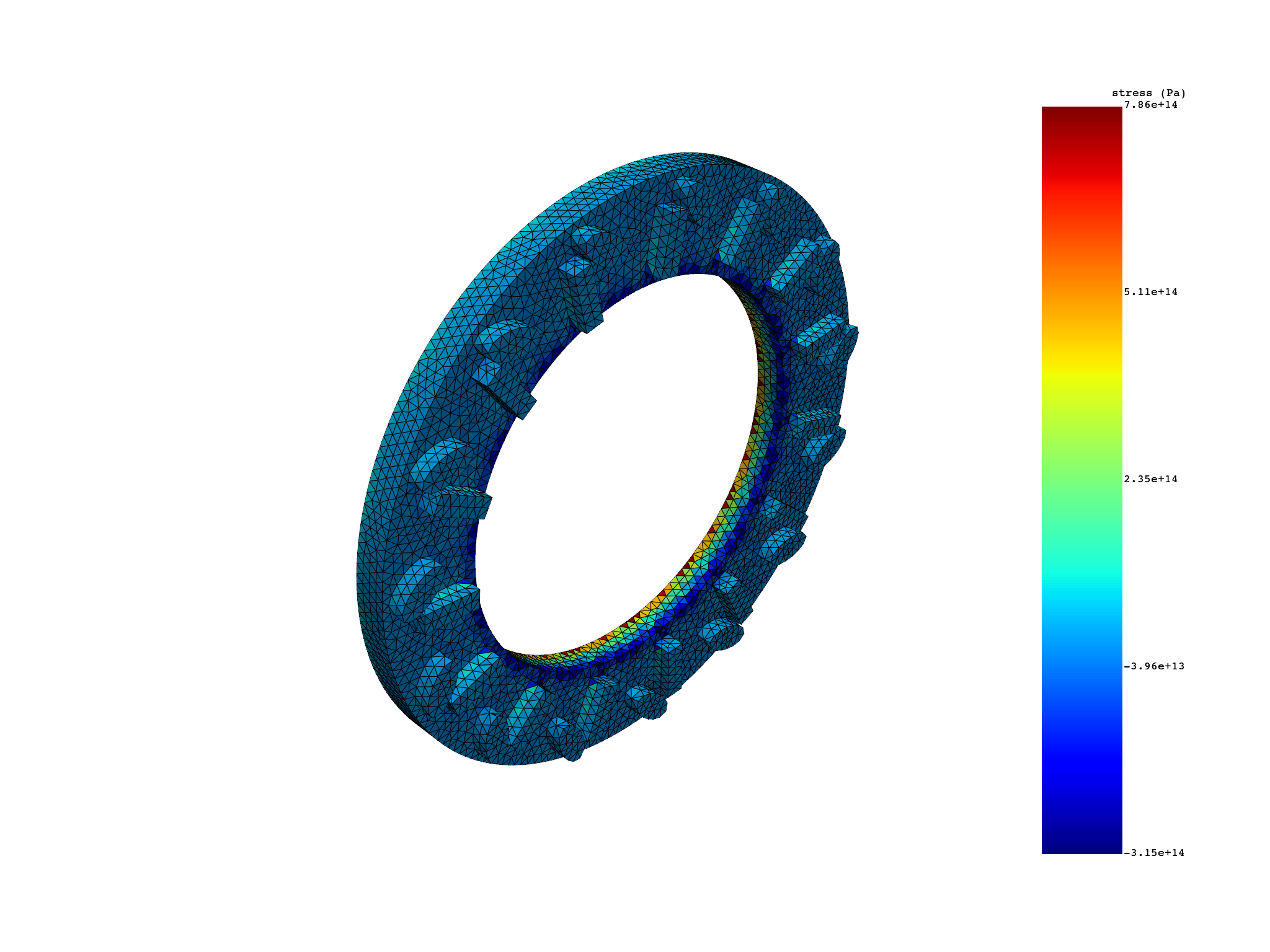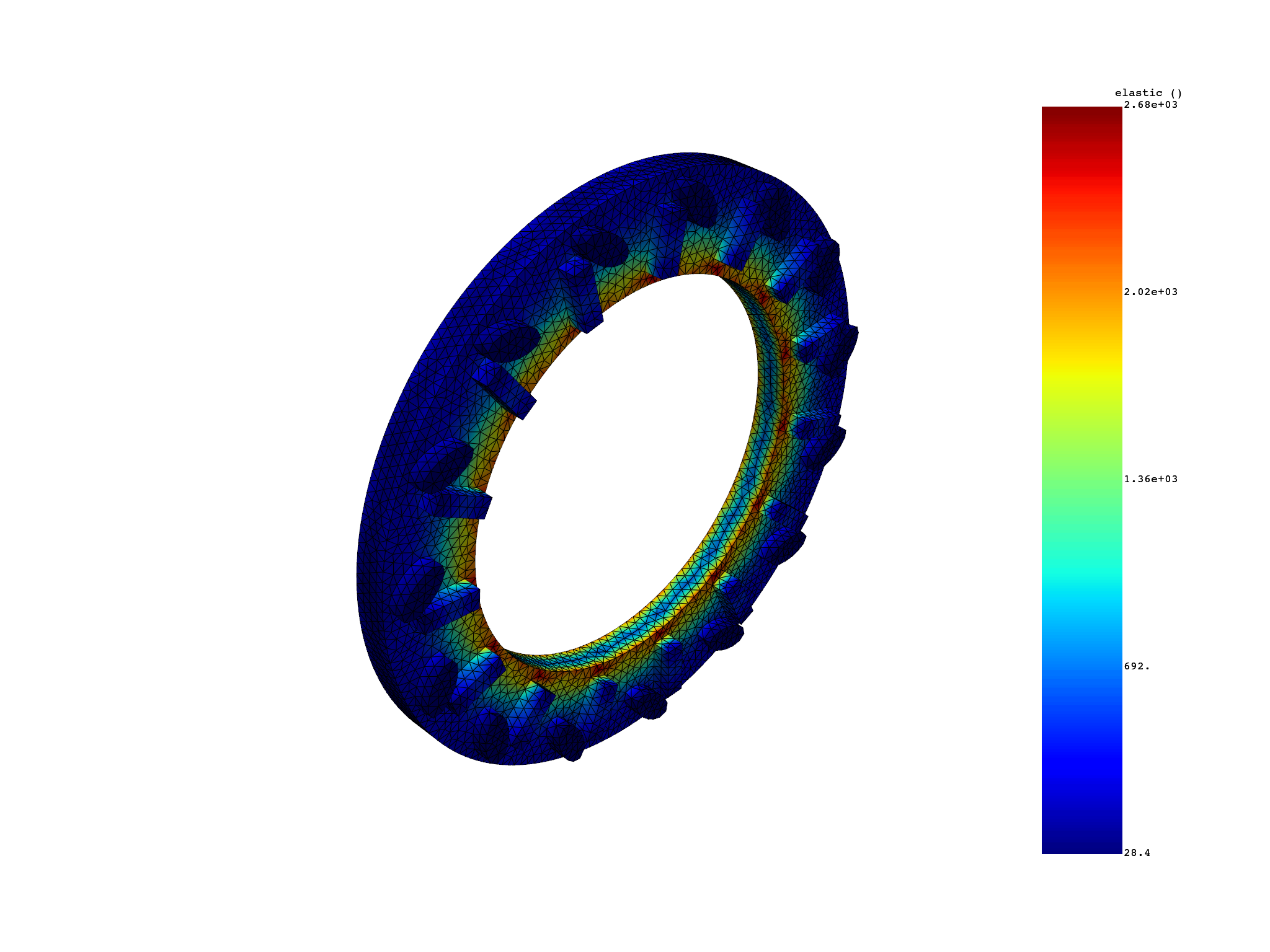Note
Go to the end to download the full example code.
Reduce cyclic model size by using the mesh external layer for result and mesh extraction#
This example shows postprocessing on a mesh external layer for a cyclic modal analysis. The external layer is the layer of solid elements with at least one facet facing the outside of the geometry.
This feature, available for all types of mechanical simulation supporting cyclic or cyclic multi-stage models, allows you to reduce the size of both the mesh and the extracted data to improve processing performance. Because larger stresses and strains are usually located on the skin of a model, computing results on the external layer gives equivalent maximum values in most cases.
Perform required imports#
Perform required imports. This example uses a supplied file that you can
get using the examples module.
from ansys.dpf import post
from ansys.dpf.post import examples
Get Simulation object#
Get the Simulation object that allows access to the result. The Simulation
object must be instantiated with the path for the result file. For example,
"C:/Users/user/my_result.rst" on Windows or "/home/user/my_result.rst"
on Linux.
example_path = examples.download_modal_cyclic()
simulation = post.ModalMechanicalSimulation(example_path)
# print the simulation to get an overview of what's available
print(simulation)
Modal Mechanical Simulation.
Data Sources
------------------------------
/opt/hostedtoolcache/Python/3.10.19/x64/lib/python3.10/site-packages/ansys/dpf/core/examples/result_files/cyclic/modal_cyclic.rst
DPF Model
------------------------------
Modal analysis
Unit system: MKS: m, kg, N, s, V, A, degC
Physics Type: Mechanical
Available results:
- node_orientations: Nodal Node Euler Angles
- displacement: Nodal Displacement
- reaction_force: Nodal Force
- stress: ElementalNodal Stress
- elastic_strain: ElementalNodal Strain
- elastic_strain_eqv: ElementalNodal Strain eqv
- element_orientations: ElementalNodal Element Euler Angles
------------------------------
DPF Meshed Region:
928 nodes
3836 elements
Unit: m
With solid (3D) elements
------------------------------
DPF Time/Freq Support:
Number of sets: 48
Cumulative Frequency (Hz) LoadStep Substep Harmonic index
1 51369.575105 1 1 0.000000
2 114291.419744 1 2 0.000000
3 238849.856755 1 3 0.000000
4 254031.324493 1 4 0.000000
5 337729.470910 1 5 0.000000
6 348699.692284 1 6 0.000000
7 51970.152101 2 1 1.000000
8 51970.152101 2 2 -1.000000
9 126647.471593 2 3 -1.000000
10 126647.471593 2 4 1.000000
11 239807.889703 2 5 -1.000000
12 239807.889703 2 6 1.000000
13 54198.644112 3 1 2.000000
14 54198.644112 3 2 -2.000000
15 157264.852222 3 3 -2.000000
16 157264.852222 3 4 2.000000
17 242073.194077 3 5 -2.000000
18 242073.194077 3 6 2.000000
19 59105.565170 4 1 3.000000
20 59105.565170 4 2 -3.000000
21 194873.849513 4 3 -3.000000
22 194873.849513 4 4 3.000000
23 241988.808784 4 5 3.000000
24 241988.808784 4 6 -3.000000
25 67744.544169 5 1 4.000000
26 67744.544169 5 2 -4.000000
27 218600.039108 5 3 -4.000000
28 218600.039108 5 4 4.000000
29 229679.308122 5 5 4.000000
30 229679.308122 5 6 -4.000000
31 80576.477155 6 1 5.000000
32 80576.477155 6 2 -5.000000
33 192985.645574 6 3 -5.000000
34 192985.645574 6 4 5.000000
35 245990.772448 6 5 5.000000
36 245990.772448 6 6 -5.000000
37 97381.706833 7 1 6.000000
38 97381.706833 7 2 -6.000000
39 166306.784163 7 3 -6.000000
40 166306.784163 7 4 6.000000
41 259986.167834 7 5 6.000000
42 259986.167834 7 6 -6.000000
43 117422.022015 8 1 7.000000
44 117422.022015 8 2 -7.000000
45 141309.163007 8 3 -7.000000
46 141309.163007 8 4 7.000000
47 273449.890447 8 5 -7.000000
48 273449.890447 8 6 7.000000
Extract displacement data#
Extract displacement data on the external layer.
displacement_ext = simulation.displacement(external_layer=True)
print(displacement_ext)
displacement_ext.plot()
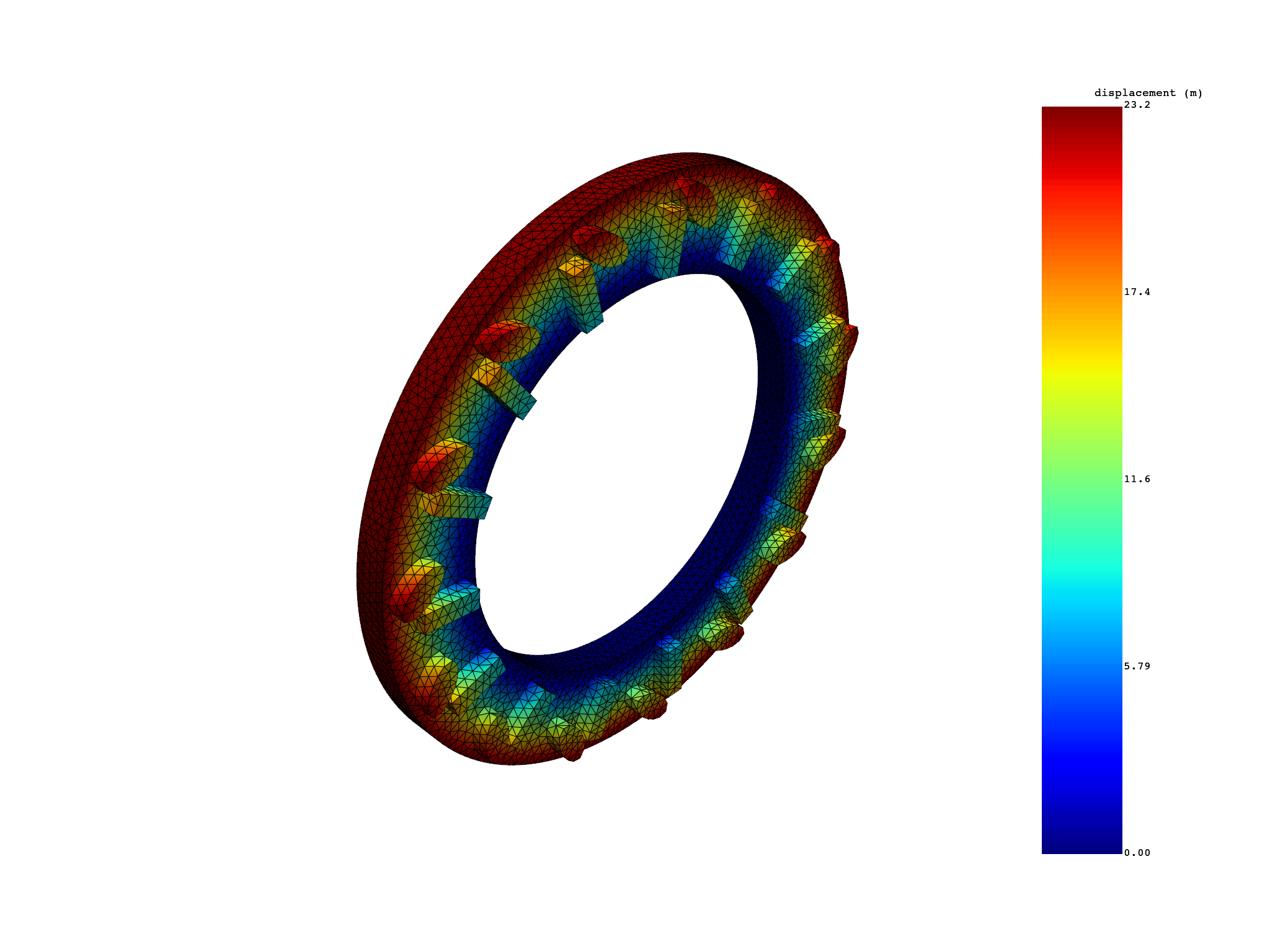
results U (m)
set_ids 1
node_ids components
225 X 4.7760e-02
Y 2.2679e+01
Z -1.4026e-02
1153 X 3.7926e-02
Y 2.2679e+01
Z -3.2239e-02
... ... ...
(None, <pyvista.plotting.plotter.Plotter object at 0x7f7716612fb0>)
Select sectors for expansion#
Extract displacement data on the external layer for a cyclic expansion on a selected number of sectors.
displacement_ext = simulation.displacement(external_layer=True, expand_cyclic=[1, 2, 3])
displacement_ext.plot()
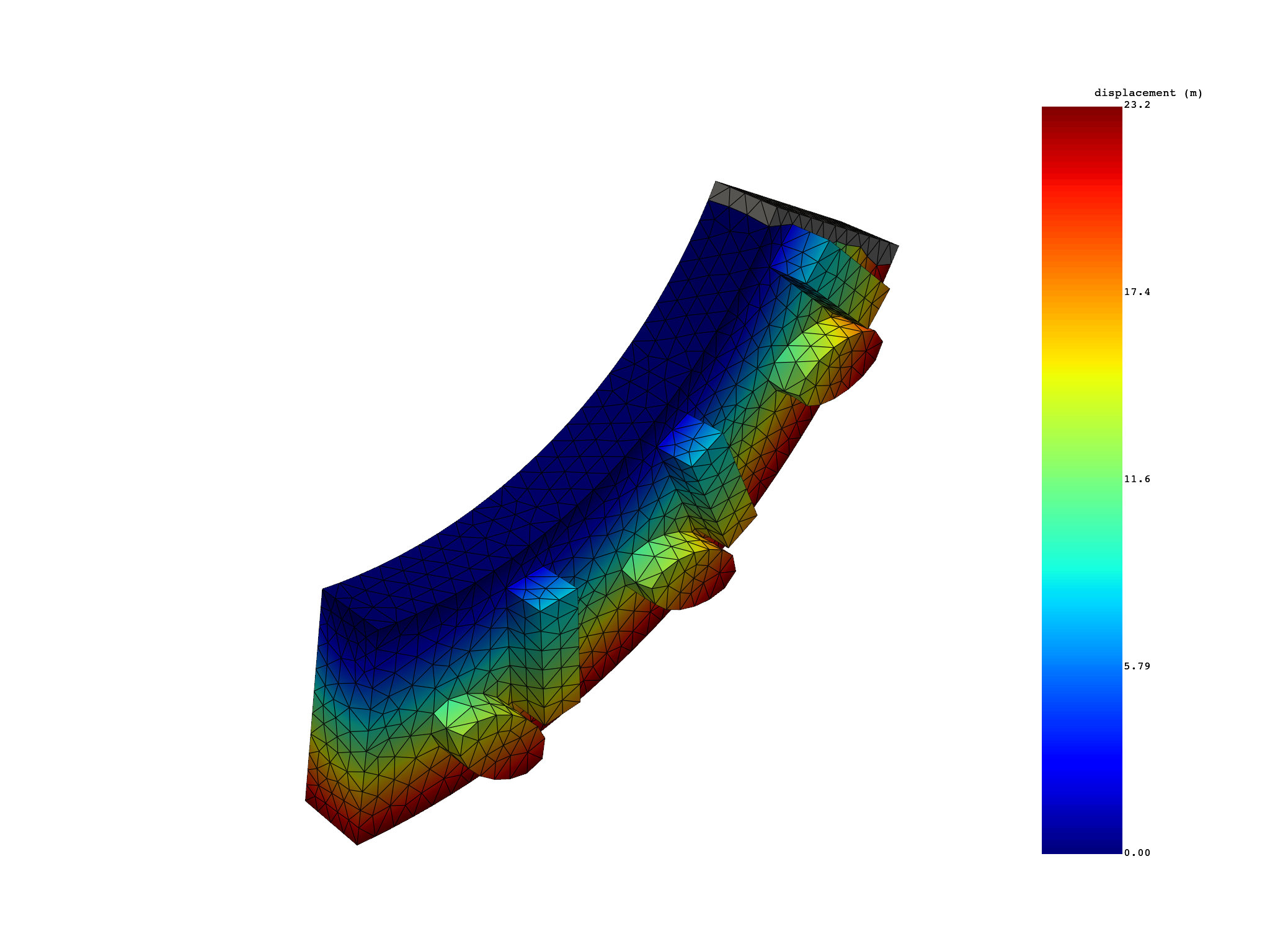
(None, <pyvista.plotting.plotter.Plotter object at 0x7f7716611450>)
Extract stress and strain data#
Extract stress and elastic strain data on the external layer. You can easily compute averages and invariants on the external layer because the connectivity of the kept elements remains unchanged.
elemental_stress_ext = simulation.stress_principal_elemental(
components=[1], external_layer=True
)
elemental_stress_ext.plot()
elastic_strain_eqv_ext = simulation.elastic_strain_eqv_von_mises_nodal(
external_layer=True
)
elastic_strain_eqv_ext.plot()
(None, <pyvista.plotting.plotter.Plotter object at 0x7f7716612fe0>)
Get stress results on external layer of first sector with a cyclic phase#
stress_eqv_cyc_phase = simulation.stress_eqv_von_mises_nodal(
set_ids=[5],
expand_cyclic=[1],
phase_angle_cyclic=45.0,
external_layer=True,
)
stress_eqv_cyc_phase.plot()
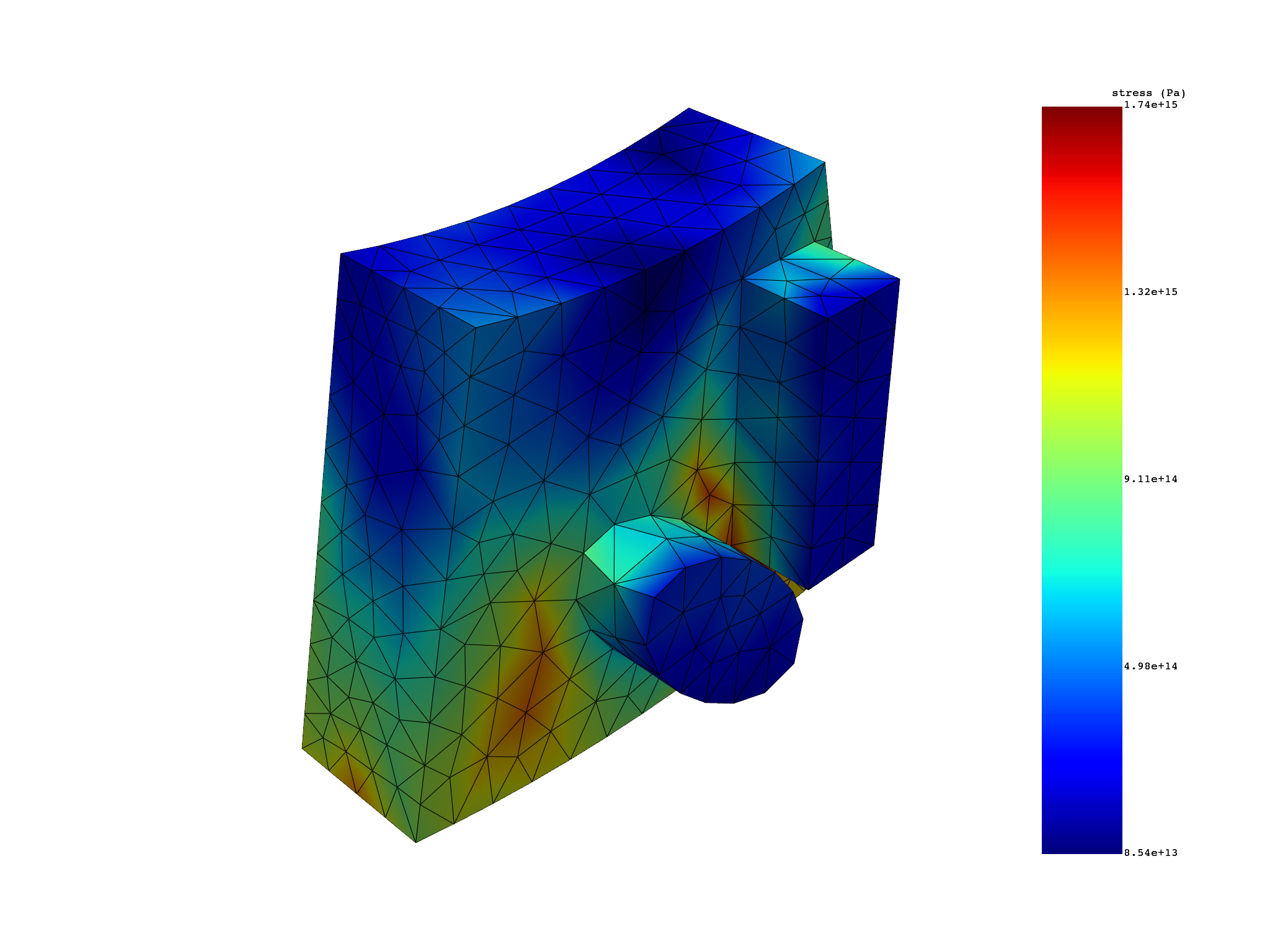
(None, <pyvista.plotting.plotter.Plotter object at 0x7f7716610bb0>)
Total running time of the script: (0 minutes 5.128 seconds)


